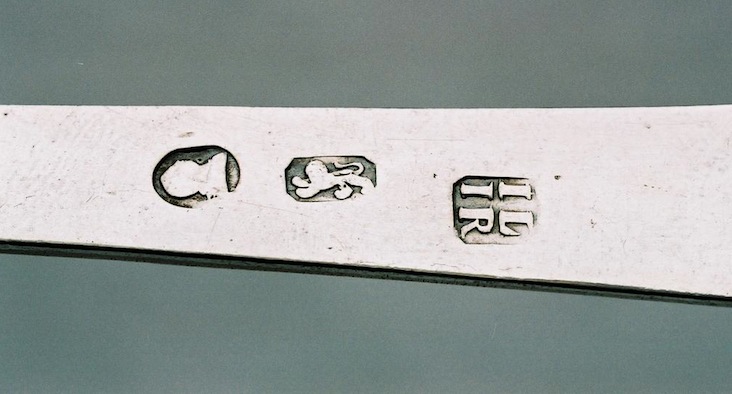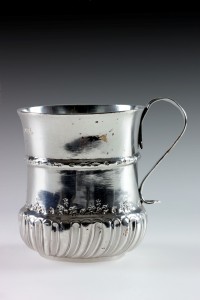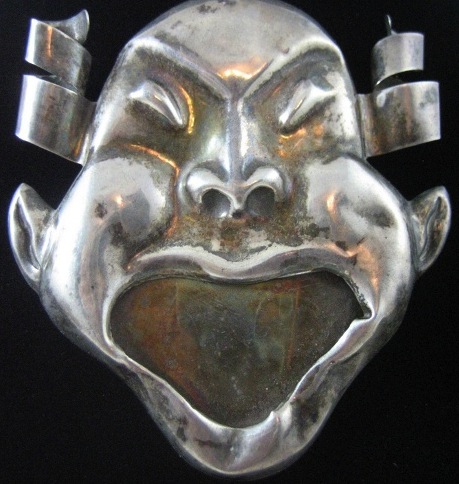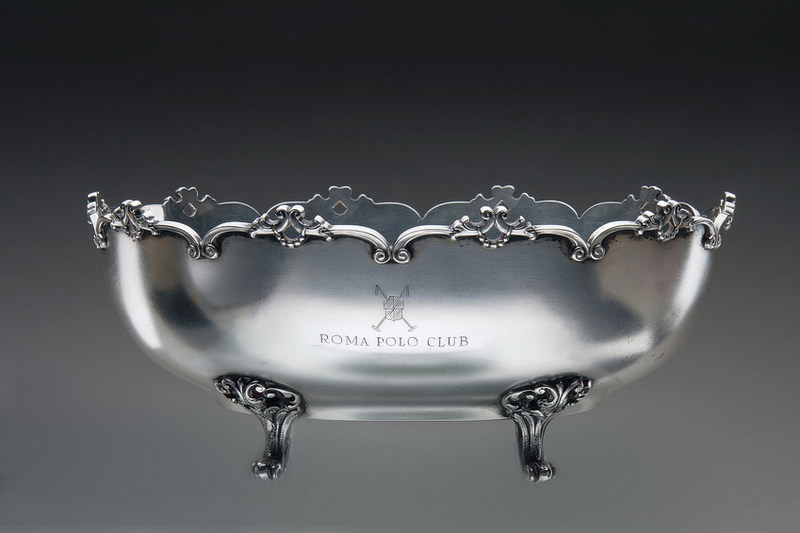NEWCASTLE, England (1702 – 1884)
Newcastle (closed 1884)

From 1248 Newcastle was an important enough town to support a number of goldsmiths. Goldsmiths are craftsmen working in precious metals, and they made objects such as snuff boxes, church chalices and coffee pots in both silver and gold. In the 18th century, increasing merchant and industrial wealth created a growing demand for luxury goods, and the Goldsmiths’ Company of Newcastle was founded in 1716, separating itself from other craft guilds. Throughout the 18th century more and more goldsmiths set themselves up in business on Tyneside, and the area of Newcastle around The Side became the centre of the silver industry.
There are 2 types of stamped marks on the base of this mug. These are the maker’s mark and the ‘town mark’. At this time Newcastle’s town mark took the form of a single castle, probably taken from the borough’s Coat of Arms. Here the head of a goat has been used in place of the castle. When this piece was made, the words ‘gate’ and ‘goat’ were the same and so the goat motif became associated with Gateshead. Augustin Floate had a shop on the Gateshead side of the Old Tyne Bridge.
Porringers were used to serve gruels, porridges or other thick liquid foods. This example shows the highly fashionable ‘Chinoiserie’ decoration of exotic birds and flowers, loosely copied from Chinese porcelain. This oriental style was rarely produced on work made outside of London and this porringer is naively decorated in comparison with more refined silver produced in this style in London. William Ramsay was Newcastle’s foremost goldsmith of his age. He appears to have been a busy and successful goldsmith and trained eleven apprentices during his career. He was also the City’s Lord Mayor in 1690.
This coffee pot was reputedly owned by Richard Grainger, the builder-developer who transformed Newcastle in the 1830s and 1840s. It is elaborately decorated in the ornate rococo style that was fashionable at this time. The pot bears the embossed coat of arms of Newcastle and the finial is shaped like the Newcastle crest with a lion rising out from a turret. William Partis was one of the four leading Newcastle silver-smiths around the middle of the 18th century.
![]() TABLE OF NEWCASTLE DATE LETTERS • 1658 – 1883
TABLE OF NEWCASTLE DATE LETTERS • 1658 – 1883
City of Newcastle


 |
 |
 |
 |
 |
|
NEWCASTLE MAKERS’ MARKS
| AK | Alexander Kelty | IR | John Robertson |
| AR | Anne Robertson | IS | John Stoddart |
| Ba | Francis Batty | IW | John Walton |
| Bi | Eli Bilton | La | John Langwith |
| Bu | John Buckle | L & S | Lister & Sons |
| CJR | Christian Reid Junior | MA | Mary Ashworth |
| CR DR |
Christian & David Reid |
Ra | John Ramsay |
| CR IS |
Christian Reid & John Stoddart |
R & D | Robertson & Darling |
| DC | David Crawford | RM | Robert Makepeace |
| DD | David Darling | RP RS |
Pinkney & Scott |
| RS | Robert Scott | ||
| DL | Dorothy Langlands | TP | Thomas Partis |
| DR | David Reid | TS | Thomas Sewill |
| FB | Francis Batty | TW | Thomas Watson |
| GB | George Bulman | WL | William Lister |
| IC | Isaac Cookson | WL CL WL |
Lister & Sons |
| IK | James Kirkup | Yo | John Younghusband |
| IL IR |
John Langlands & John Robertson |
||
| IM | John Mitchison |
Credit: http://www.twmuseums.org.uk














